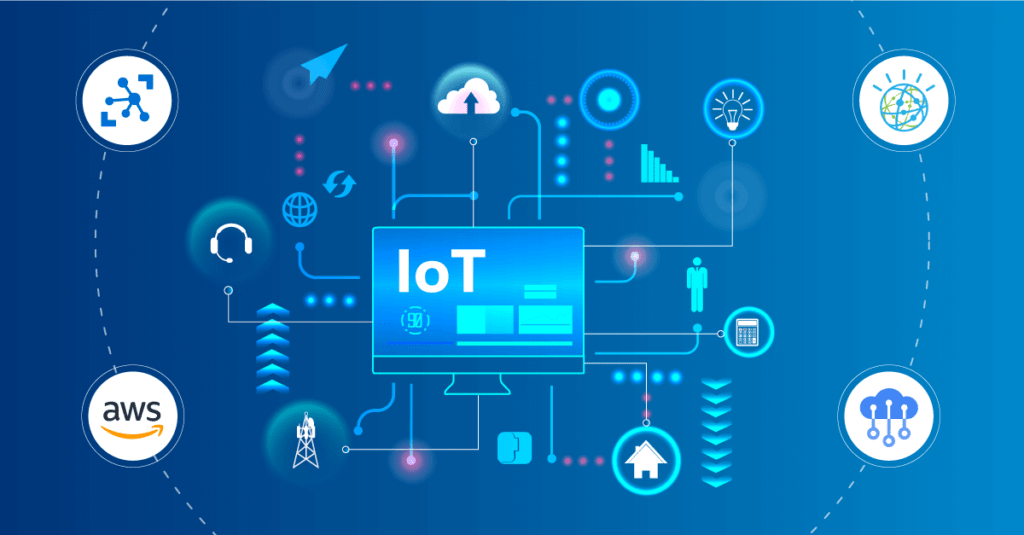Building IoT (Internet of Things) applications involves a multi-faceted process that combines hardware and software components to create systems that collect, process, and act on data from connected devices. Here’s a general overview of how to build an IoT application. There are 2 ways to build IoT applications, you can build custom applications or you can use the IoT platforms like Thingsup.
Challenges of Custom IoT Applications Development:
Developing custom IoT applications can be complex and challenging due to several reasons:
1. High Development Costs:
Building custom IoT applications often requires substantial financial investments in hardware, software, and talent.
2. Time-Consuming:
Custom development can be time-consuming, as it involves creating solutions from scratch, which delays time-to-market.
3. Scalability Issues:
Custom applications may struggle to scale efficiently as the number of IoT devices and data increases.
4.Security Concerns:
Security is a significant challenge, as it’s crucial to safeguard data transmitted between IoT devices and the application.
5. Integration Complexities:
Integrating with various IoT devices, protocols, and platforms can be technically challenging.
Benefits of Custom IoT Applications Development:
Despite the challenges, custom IoT application development offers several benefits:
1. Tailored Solutions:
Custom applications can be designed to meet specific business needs and requirements.
2. Full Control:
Organizations have complete control over the application’s features, design, and data.
3. Competitive Advantage:
Custom solutions can provide a unique competitive advantage by offering features that off-the-shelf solutions lack.
4. Data Ownership:
Organizations retain full ownership and control of their data.
5. Scalability:
With proper planning and design, custom applications can be scaled to accommodate growing IoT ecosystems.
Benefits of Using IoT Platforms:
IoT platforms are pre-built, comprehensive solutions that offer their own set of advantages:
1. Rapid Deployment:
IoT platforms are quicker to implement, reducing time-to-market for IoT applications.
2. Cost-Efficiency:
They often provide cost-effective solutions, eliminating the need for extensive custom development.
3. Scalability:
IoT platforms are designed to handle large-scale IoT deployments and can easily scale as your needs grow.
4. Security Features:
Many IoT platforms include built-in security measures to protect data and devices.
5. Integration:
IoT platforms often come with pre-built integrations for various IoT devices and protocols, simplifying connectivity.
Low-Code and No-Code IoT Platforms and Their Differences:
1. Low-Code IoT Platforms:
Low-code IoT platforms provide a visual development environment with a certain degree of coding flexibility. Developers can use pre-built components and templates to accelerate the development process. Key characteristics of low-code IoT platform include:
- Customization: Developers can write code for specific features or integrations, but it’s not mandatory.
- Faster Development: Low-code platforms speed up development by reducing the need for extensive manual coding.
- Flexibility: They strike a balance between customization and ease of use.
2. No-Code IoT Platforms:
No-code IoT platforms are designed for users with little to no coding experience. They emphasize simplicity and require minimal to no coding. Key characteristics of no-code IoT platforms include:
- Drag-and-Drop Interface: Users can build applications by dragging and dropping elements onto a visual canvas.
- Accessibility: No-code platforms are user-friendly and accessible to a broader range of individuals.
- Speed: They offer the quickest path to IoT application development due to their simplicity.
Challenges of Low-Code or No-Code IoT Platforms:
While low-code and no-code IoT platforms offer simplicity and speed, they come with their own set of challenges:
- Limited Customization: These platforms may not support highly customized solutions. Organizations with unique requirements might find them restrictive.
- Scalability: No-code platforms, in particular, may struggle to handle complex and large-scale IoT deployments.
- Dependency: Organizations using no-code platforms may become heavily dependent on the platform provider, which could be a risk.
- Learning Curve: Users may still need some level of training or familiarity with the platform, especially with low-code solutions.
Conclusion: Hybrid Platform (Low-Code Is Clear Winner):
In the IoT application development landscape, a hybrid approach that combines low-code development with customization is often the most pragmatic choice. Here’s why low-code stands out as the clear winner:
- Speed and Simplicity: Low-code platforms offer the advantage of rapid development, making them more time-efficient than custom development.
- Customization: Low-code platforms allow organizations to add custom features and integrations when needed, offering a level of flexibility that pure no-code platforms lack.
- Cost-Efficiency: Low-code platforms can be more cost-effective than custom development, striking a balance between tailored solutions and affordability.
- Reduced Learning Curve: They have a lower learning curve compared to pure custom development, making them accessible to a broader audience within the organization.
In summary, the choice between custom development, IoT platform, low-code, or no-code solutions depends on your specific needs, resources, and the balance you wish to strike between customization, speed, and cost-efficiency. For many, a hybrid approach that leverages low-code development while retaining the ability to customize as necessary proves to be the most efficient and effective path for IoT application development.






